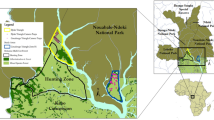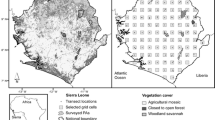Abstract
Current deforestation practices are likely to result in fragmentation of much of Amazonia. Extreme eastern Amazonia (here referring to the region east of the Tocantins River) is the most populated area of the Brazilian Amazon and, unfortunately, represents the likely future scenario for remaining Amazonia. Although data are available on mammals in central Amazon fragments (the BDFFP project, http://pdbff.inpa.gov.br/), surprisingly little is known about mammalian distribution and responses to fragmentation in eastern Amazonia. As an initial step towards understanding these responses, we compiled available data on mammalian assemblage composition in four fragments east of the Tocantins River, in northeastern Pará, Brazil, between 2002 and 2006. These fragments are privately owned and embedded within a matrix of secondary forest, pasture, slash-and-burn agriculture, and roads. Survey methods included diurnal line transect censusing, nocturnal censusing, live trapping of small mammals, opportunistic observations, and interviews with local informants. Despite environmental stresses, nearly all of the expected large mammalian fauna was recorded at least once, providing reason for optimism. We documented 58 species of mammals in nine orders, and most species we failed to encounter were small nocturnal taxa for which our sampling effort likely was inadequate. Although preliminary in nature, this study highlights the need for comprehensive faunal surveys and complementary ecological research on the fauna of extreme eastern Amazonia. It also indicates that the terrestrial fauna of the region shows indications of resilience in spite of a long history of exploitation.

Similar content being viewed by others
References
Bierregaard RO, Lovejoy TE, Kapos V, Santos RA, Hutchings RW (1992) The biological dynamics of tropical rainforest fragments. Bioscience 42:59–866. doi:10.2307/1312085
Bierregaard RO, Gascon C Jr, Lovejoy TE, Mesquita R (2001) Lessons from Amazonia: the ecology and conservation of a fragmented forest. Yale University Press, London
Burnham KP, Anderson DR, Laake JL (1980) Estimation of density from line transect sampling of biological populations. Wildl Monogr 72:1–202
Carvalho Júnior O (2003) Primates in a forest fragment in Eastern Amazonia. Neotrop Primates 11:100–102
Cerqueira R (1985) The distribution of Didelphis in South America (Polyprotodontia, Didelphidae). J Biogeogr 12:135–145. doi:10.2307/2844837
Costa LP, Leite YLR, Mendes SL, Ditchfield AD (2005) Mammal conservation in Brazil. Conserv Biol 19:672–679. doi:10.1111/j.1523-1739.2005.00666.x
Cuaron AD (2000) A global perspective on habitat disturbance and tropical rainforest mammals. Conserv Biol 14:1574–1579. doi:10.1046/j.1523-1739.2000.99211.x
D’Elia G (2003) Phylogenetics of Sigmodontinae (Rodentia, Muroidea, Cricetidae), with special reference to the akodont group, and with additional comments on historical biogeography. Cladistics 19:307–323. doi:10.1016/S0748-3007(03)00071-9
Daily GC (2001) Ecological forecasts. Nature 411:245. doi:10.1038/35077178
Emmons LH, Feer F (1997) Neotropical rainforest mammals: a field guide. The University of Chicago Press, Chicago
Ferrari SF, Iwanaga S, Ravetta AL, Freitas FC, Sousa BAR, Souza LL et al (2003) Dynamics of primate communities along the Santarem–Cuiaban highway in south-central Brazilian Amazonia. In: Marsh LK (ed) Primates in fragments: ecology and conservation. Plenum Press, New York
Gregorin R (2006) Taxonomia e variação geográfica das espécies do gênero Alouatta Lacépède (Primates, Atelidae) no Brasil. Rev Bras Zoologia 23:64–144
Hershkovitz P (1977) Living New World monkeys (Platyrrhini), vol 1. The University of Chicago Press, Chicago
Hershkovitz P (1983) Two new species of night monkeys, genus Aotus (Cebidae, Platyrrhini): a preliminary report on Aotus taxonomy. Am J Primatol 4:209–243. doi:10.1002/ajp.1350040302
Hershkovitz P (1984) Taxonomy of the squirrel monkey genus Saimiri (Cebidae, Platyrrhini): a preliminary report with description of a hitherto unnamed form. Am J Primatol 7:155–210. doi:10.1002/ajp.1350070212
Hershkovitz P (1985) A preliminary taxonomic review of the South American bearded saki monkeys genus Chiropotes (Cebidae, Platyrrhini), with description of a new subspecies. Fieldiana: Zoology, new series 27:1–45
Lambert TD, Malcolm JR, Zimmerman BL (2006) Amazonian small mammal abundances in relation to habitat structure and resource abundance. J Mammal 87:766–776. doi:10.1644/05-MAMM-A-261R1.1
Laurance WF (1998) A crisis in the making: responses of Amazonian forests to land use and climate change. Trends Ecol Evol 13:411–415. doi:10.1016/S0169-5347(98)01433-5
Laurance WF, Bierregaard RO (1997) Tropical forest remnants. The University of Chicago Press, Chicago, Illinois
Laurance WF, Cochrane MA, Bergen S, Fearnside PM, Delamônica P, Barber C et al (2001) The future of the Brazilian Amazon. Science 291:438–439. doi:10.1126/science.291.5503.438
Lopes MA (1993) Primate conservation in eastern Brazilian Amazonia. Neotrop Primates 1:8–9
Lopes MA, Ferrari SF (2000) Effects of human colonization on the abundance and diversity of mammals in eastern Brazilian Amazonia. Conserv Biol 14:1658–1665. doi:10.1046/j.1523-1739.2000.98402.x
Machado ABM (2005) Lista da fauna brasileira ameaçada de extinção incluindo as espécies quase ameaçadas e deficientes em dados. In: Machado ABM, Martins CS, Drummond GM (eds) Primatas do Brasil. Fundação Biodiversitas, Belo Horizonte Pp. 1995
Malcolm JR (1991) Comparative abundances of neotropical small mammals by trap height. J Mammal 72:188–192. doi:10.2307/1381995
Malcolm JR (1997) Biomass and diversity of small mammals in Amazonian forest fragments. In: Laurance WF, Bierregaard RO (eds) Tropical forest remnants. The University of Chicago Press, Chicago, pp 207–221
Offerman HL, Dale VH, Pearson SM, Bierregaard RO, O’Neill RV (1995) Effects of forest fragmentation on neotropical fauna: current research and data availability. Environ Rev 3:191–211
Oliveira TG, Cassaro K (2005) Guia de campo dos felinos brasileiros. Sociedade de Zoológicos do Brasil, São Paulo
Patterson BD (2001) Fathoming tropical biodiversity: the continuing discovery of neotropical mammals. Divers Distrib 7:191–196. doi:10.1111/j.1472-4642.2001.00109.x
Pine RH (1973) Mammals (exclusive of bats) of Belém, Pará, Brazil. Acta Amazon 3:47–79
Queiroz HL (1992) A new species of capuchin monkey, genus Cebus Erxleben, 1777 (Cebidae: Primates) from eastern Brazilian Amazonia. Goeldiana Zoologia 14:1–17
Reis NR, Peracchi AL, Pedro WA, Lima IP (2006) Mamíferos do Brasil. Universidade Estadual de Londrina, Londrina
Silva Júnior JS, Cerqueira R (1998) New data and a historical sketch on the geographical distribution of the ka’apor capuchin, Cebus kaapori Queiroz, 1992 (Primates, Cebidae). Neotrop Primates 6:118–121
Silva Júnior JS, Fernandes MEB (1999) A northeastern extension of the distribution of Aotus infulatus in Maranhão, Brazil. Neotrop Primates 7:76–80
Silva Júnior JS, Nunes AP (2000) An extension of the distribution of Dactylomys dactylinus Desmarest, 1822 (Rodentia, Echimyidae). Boletim do Museu Paraense Emílio Goeldi série Zoologia 16:5–73
Silva MNF, Rylands AB, Patton JL (2001) Biogeografia e conservação da mastofauna na floresta amazônica brasileira. In: Capobiano JPR (ed) Biodiversidade na Amazônia Brasileira: avaliações e ações prioritárias para a conservação, uso sustentável e repartição de benefícios. Estação Liberdade/Intituto Sócio-ambiental, São Paulo, pp 110–131
Simmons NB, Voss RS (2001) The mammals of Paracou, French Guiana: a neotropical lowland rainforest fauna, part 1: bats. Bull Am Mus Nat Hist 237:1–219. doi:10.1206/0003-0090(2001)258<0001:PROMBC>2.0.CO;2
Skole D, Tucker C (1993) Tropical deforestation and habitat fragmentation in the Amazon: satellite data from 1978 to 1988. Science 260:1905–1910. doi:10.1126/science.260.5116.1905
Stone AI (2007) Responses of squirrel monkeys to seasonal changes in food availability in an eastern Amazonian rainforest. Am J Primatol 69:142–157. doi:10.1002/ajp.20335
Umetsu F, Naxara L, Pardini R (2006) Evaluating the efficiency of pitfall traps for sampling small mammals in the Neotropics. J Mammal 87:757–765. doi:10.1644/05-MAMM-A-285R2.1
Vandermeer J, Perfecto I (2007) The agricultural matrix and a future paradigm for conservation. Conserv Biol 21:274–277. doi:10.1111/j.1523-1739.2006.00582.x
Voss RS, Emmons LH (1996) Mammalian diversity in Neotropical lowland rainforests: a preliminary assessment. Bull Am Mus Nat Hist 230:1–115
Voss RS, Lunde DP, Simmons NB (2001) The mammals of Paracou, French Guiana: a neotropical lowland rainforest fauna, part 2: nonvolant species. Bull Am Mus Nat Hist 263:3–236. doi:10.1206/0003-0090(2001)263<0003:TMOPFG>2.0.CO;2
Weksler M, Percequillo AR, Voss RS (2006) Ten new genera or Oryzomyine rodents (Cricetidae: Sigmodontinae). Am Mus Novit 3537:1–29. doi:10.1206/0003-0082(2006)3537[1:TNGOOR]2.0.CO;2
Ximenes GEI (1999) Sistemática da família Dasyproctidae Bonaparte, 1838 (Rodentia, Histricognathi) no Brasil. M.Sc. thesis, Universidade de São Paulo, São Paulo, 429 pp.
Acknowledgments
The authors thank Celso Ferreira for permission to work FMV and Edmilson Viana da Silva for assistance in the field. We thank Pércio and Thales Lima for permission to work at FV, Oriana Almeida (IPAM) for logistical support and Francisco Benedito Rodrigues for field assistance. At FRC, José, Manoel, Damião, João Bosco and Aparecida Calixto Pereira Dias of CIKEL Brasil Verde Ltda. provided permission and field assistance. Josué Evandro R. Ferreira provided support and helpful suggestions. Funding was provided by Companhia Vale do Rio Doce and the Department of Wildlife, Fish and Conservation Biology at UC-Davis. We thank Shaily Menon and two anonymous reviewers for comments on a previous version of the manuscript.
Author information
Authors and Affiliations
Corresponding author
Rights and permissions
About this article
Cite this article
Stone, A.I., Lima, E.M., Aguiar, G.F.S. et al. Non-volant mammalian diversity in fragments in extreme eastern Amazonia. Biodivers Conserv 18, 1685–1694 (2009). https://doi.org/10.1007/s10531-008-9551-9
Received:
Accepted:
Published:
Issue Date:
DOI: https://doi.org/10.1007/s10531-008-9551-9




